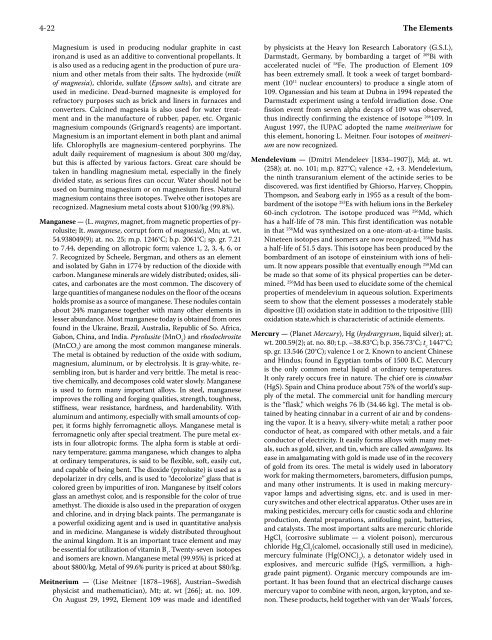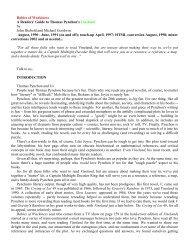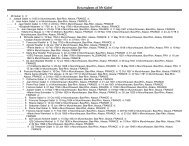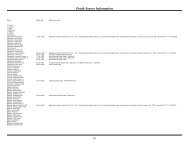CRC Handbook of Chemistry and Physics, 86th Edition
CRC Handbook of Chemistry and Physics, 86th Edition
CRC Handbook of Chemistry and Physics, 86th Edition
Create successful ePaper yourself
Turn your PDF publications into a flip-book with our unique Google optimized e-Paper software.
4-22 The Elements<br />
Magnesium is used in producing nodular graphite in cast<br />
iron,<strong>and</strong> is used as an additive to conventional propellants. It<br />
is also used as a reducing agent in the production <strong>of</strong> pure uranium<br />
<strong>and</strong> other metals from their salts. The hydroxide (milk<br />
<strong>of</strong> magnesia), chloride, sulfate (Epsom salts), <strong>and</strong> citrate are<br />
used in medicine. Dead-burned magnesite is employed for<br />
refractory purposes such as brick <strong>and</strong> liners in furnaces <strong>and</strong><br />
converters. Calcined magnesia is also used for water treatment<br />
<strong>and</strong> in the manufacture <strong>of</strong> rubber, paper, etc. Organic<br />
magnesium compounds (Grignard’s reagents) are important.<br />
Magnesium is an important element in both plant <strong>and</strong> animal<br />
life. Chlorophylls are magnesium-centered porphyrins. The<br />
adult daily requirement <strong>of</strong> magnesium is about 300 mg/day,<br />
but this is affected by various factors. Great care should be<br />
taken in h<strong>and</strong>ling magnesium metal, especially in the finely<br />
divided state, as serious fires can occur. Water should not be<br />
used on burning magnesium or on magnesium fires. Natural<br />
magnesium contains three isotopes. Twelve other isotopes are<br />
recognized. Magnesium metal costs about $100/kg (99.8%).<br />
Manganese — (L. magnes, magnet, from magnetic properties <strong>of</strong> pyrolusite;<br />
It. manganese, corrupt form <strong>of</strong> magnesia), Mn; at. wt.<br />
54.938049(9); at. no. 25; m.p. 1246°C; b.p. 2061°C; sp. gr. 7.21<br />
to 7.44, depending on allotropic form; valence 1, 2, 3, 4, 6, or<br />
7. Recognized by Scheele, Bergman, <strong>and</strong> others as an element<br />
<strong>and</strong> isolated by Gahn in 1774 by reduction <strong>of</strong> the dioxide with<br />
carbon. Manganese minerals are widely distributed; oxides, silicates,<br />
<strong>and</strong> carbonates are the most common. The discovery <strong>of</strong><br />
large quantities <strong>of</strong> manganese nodules on the floor <strong>of</strong> the oceans<br />
holds promise as a source <strong>of</strong> manganese. These nodules contain<br />
about 24% manganese together with many other elements in<br />
lesser abundance. Most manganese today is obtained from ores<br />
found in the Ukraine, Brazil, Australia, Republic <strong>of</strong> So. Africa,<br />
Gabon, China, <strong>and</strong> India. Pyrolusite (MnO 2 ) <strong>and</strong> rhodochrosite<br />
(MnCO 3 ) are among the most common manganese minerals.<br />
The metal is obtained by reduction <strong>of</strong> the oxide with sodium,<br />
magnesium, aluminum, or by electrolysis. It is gray-white, resembling<br />
iron, but is harder <strong>and</strong> very brittle. The metal is reactive<br />
chemically, <strong>and</strong> decomposes cold water slowly. Manganese<br />
is used to form many important alloys. In steel, manganese<br />
improves the rolling <strong>and</strong> forging qualities, strength, toughness,<br />
stiffness, wear resistance, hardness, <strong>and</strong> hardenability. With<br />
aluminum <strong>and</strong> antimony, especially with small amounts <strong>of</strong> copper,<br />
it forms highly ferromagnetic alloys. Manganese metal is<br />
ferromagnetic only after special treatment. The pure metal exists<br />
in four allotropic forms. The alpha form is stable at ordinary<br />
temperature; gamma manganese, which changes to alpha<br />
at ordinary temperatures, is said to be flexible, s<strong>of</strong>t, easily cut,<br />
<strong>and</strong> capable <strong>of</strong> being bent. The dioxide (pyrolusite) is used as a<br />
depolarizer in dry cells, <strong>and</strong> is used to “decolorize” glass that is<br />
colored green by impurities <strong>of</strong> iron. Manganese by itself colors<br />
glass an amethyst color, <strong>and</strong> is responsible for the color <strong>of</strong> true<br />
amethyst. The dioxide is also used in the preparation <strong>of</strong> oxygen<br />
<strong>and</strong> chlorine, <strong>and</strong> in drying black paints. The permanganate is<br />
a powerful oxidizing agent <strong>and</strong> is used in quantitative analysis<br />
<strong>and</strong> in medicine. Manganese is widely distributed throughout<br />
the animal kingdom. It is an important trace element <strong>and</strong> may<br />
be essential for utilization <strong>of</strong> vitamin B 1 . Twenty-seven isotopes<br />
<strong>and</strong> isomers are known. Manganese metal (99.95%) is priced at<br />
about $800/kg. Metal <strong>of</strong> 99.6% purity is priced at about $80/kg.<br />
Meitnerium — (Lise Meitner [1878–1968], Austrian–Swedish<br />
physicist <strong>and</strong> mathematician), Mt; at. wt [266]; at. no. 109.<br />
On August 29, 1992, Element 109 was made <strong>and</strong> identified<br />
by physicists at the Heavy Ion Research Laboratory (G.S.I.),<br />
Darmstadt, Germany, by bombarding a target <strong>of</strong> 209 Bi with<br />
accelerated nuclei <strong>of</strong> 58 Fe. The production <strong>of</strong> Element 109<br />
has been extremely small. It took a week <strong>of</strong> target bombardment<br />
(10 11 nuclear encounters) to produce a single atom <strong>of</strong><br />
109. Oganessian <strong>and</strong> his team at Dubna in 1994 repeated the<br />
Darmstadt experiment using a tenfold irradiation dose. One<br />
fission event from seven alpha decays <strong>of</strong> 109 was observed,<br />
thus indirectly confirming the existence <strong>of</strong> isotope 266 109. In<br />
August 1997, the IUPAC adopted the name meitnerium for<br />
this element, honoring L. Meitner. Four isotopes <strong>of</strong> meitnerium<br />
are now recognized.<br />
Mendelevium — (Dmitri Mendeleev [1834–1907]), Md; at. wt.<br />
(258); at. no. 101; m.p. 827°C; valence +2, +3. Mendelevium,<br />
the ninth transuranium element <strong>of</strong> the actinide series to be<br />
discovered, was first identified by Ghiorso, Harvey, Choppin,<br />
Thompson, <strong>and</strong> Seaborg early in 1955 as a result <strong>of</strong> the bombardment<br />
<strong>of</strong> the isotope 253 Es with helium ions in the Berkeley<br />
60-inch cyclotron. The isotope produced was 256 Md, which<br />
has a half-life <strong>of</strong> 78 min. This first identification was notable<br />
in that 256 Md was synthesized on a one-atom-at-a-time basis.<br />
Nineteen isotopes <strong>and</strong> isomers are now recognized. 258 Md has<br />
a half-life <strong>of</strong> 51.5 days. This isotope has been produced by the<br />
bombardment <strong>of</strong> an isotope <strong>of</strong> einsteinium with ions <strong>of</strong> helium.<br />
It now appears possible that eventually enough 258 Md can<br />
be made so that some <strong>of</strong> its physical properties can be determined.<br />
256 Md has been used to elucidate some <strong>of</strong> the chemical<br />
properties <strong>of</strong> mendelevium in aqueous solution. Experiments<br />
seem to show that the element possesses a moderately stable<br />
dipositive (II) oxidation state in addition to the tripositive (III)<br />
oxidation state,which is characteristic <strong>of</strong> actinide elements.<br />
Mercury — (Planet Mercury), Hg (hydrargyrum, liquid silver); at.<br />
wt. 200.59(2); at. no. 80; t.p. –38.83°C; b.p. 356.73°C; t c 1447°C;<br />
sp. gr. 13.546 (20°C); valence 1 or 2. Known to ancient Chinese<br />
<strong>and</strong> Hindus; found in Egyptian tombs <strong>of</strong> 1500 B.C. Mercury<br />
is the only common metal liquid at ordinary temperatures.<br />
It only rarely occurs free in nature. The chief ore is cinnabar<br />
(HgS). Spain <strong>and</strong> China produce about 75% <strong>of</strong> the world’s supply<br />
<strong>of</strong> the metal. The commercial unit for h<strong>and</strong>ling mercury<br />
is the “flask,” which weighs 76 lb (34.46 kg). The metal is obtained<br />
by heating cinnabar in a current <strong>of</strong> air <strong>and</strong> by condensing<br />
the vapor. It is a heavy, silvery-white metal; a rather poor<br />
conductor <strong>of</strong> heat, as compared with other metals, <strong>and</strong> a fair<br />
conductor <strong>of</strong> electricity. It easily forms alloys with many metals,<br />
such as gold, silver, <strong>and</strong> tin, which are called amalgams. Its<br />
ease in amalgamating with gold is made use <strong>of</strong> in the recovery<br />
<strong>of</strong> gold from its ores. The metal is widely used in laboratory<br />
work for making thermometers, barometers, diffusion pumps,<br />
<strong>and</strong> many other instruments. It is used in making mercuryvapor<br />
lamps <strong>and</strong> advertising signs, etc. <strong>and</strong> is used in mercury<br />
switches <strong>and</strong> other electrical apparatus. Other uses are in<br />
making pesticides, mercury cells for caustic soda <strong>and</strong> chlorine<br />
production, dental preparations, antifouling paint, batteries,<br />
<strong>and</strong> catalysts. The most important salts are mercuric chloride<br />
HgCl 2 (corrosive sublimate — a violent poison), mercurous<br />
chloride Hg 2 Cl 2 (calomel, occasionally still used in medicine),<br />
mercury fulminate (Hg(ONC) 2 ), a detonator widely used in<br />
explosives, <strong>and</strong> mercuric sulfide (HgS, vermillion, a highgrade<br />
paint pigment). Organic mercury compounds are important.<br />
It has been found that an electrical discharge causes<br />
mercury vapor to combine with neon, argon, krypton, <strong>and</strong> xenon.<br />
These products, held together with van der Waals’ forces,







